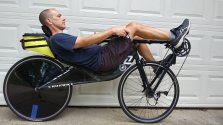Duncanleon
New Member
I've been riding for season and a half now and once I was thankfully able to get passed the "learnnng and break-in" period, I was able to actually start paying attention to speed and power output. I have follwed the formula for establishng a proper fit and have been experimenting with the position of the MBB relative to the ground. I'm curious about the aerodynamics of how the apparent wind at roughly 20 mph reacts to the body leaning back using a 20 degree seat incline.
I recently read a reposting of some of the the results from the V20 wind tunnel testing that occured a couple of years ago and I've followed some of the offhand comments and pictures from other V20 riders. Im seeing the results are very mixed and most have to do with the comfort of the fit for riding.
What are other's opinions regarding where maximum aerodynamic efficiency might be if the adjustment is made to the height of the BB and pedals relative to the height of the handlebars, the seat pan and the riding position of the body. Is it more efficient to keep the BB slightly lower allowing the body to be laying relatively straight at an angled plane thereby driving the wind along the full length of the body? Is it better to raise the pedalling feet higher to create a smaller "hole"? Would that apparent hole really be any smaller or streamlined considering the impact of the rider's face to elbows to flailing feet? If it does make a difference then at what point would the BB be considered too high which would start diminishing efficiency? Where is the happy medium?
I recently read a reposting of some of the the results from the V20 wind tunnel testing that occured a couple of years ago and I've followed some of the offhand comments and pictures from other V20 riders. Im seeing the results are very mixed and most have to do with the comfort of the fit for riding.
What are other's opinions regarding where maximum aerodynamic efficiency might be if the adjustment is made to the height of the BB and pedals relative to the height of the handlebars, the seat pan and the riding position of the body. Is it more efficient to keep the BB slightly lower allowing the body to be laying relatively straight at an angled plane thereby driving the wind along the full length of the body? Is it better to raise the pedalling feet higher to create a smaller "hole"? Would that apparent hole really be any smaller or streamlined considering the impact of the rider's face to elbows to flailing feet? If it does make a difference then at what point would the BB be considered too high which would start diminishing efficiency? Where is the happy medium?





